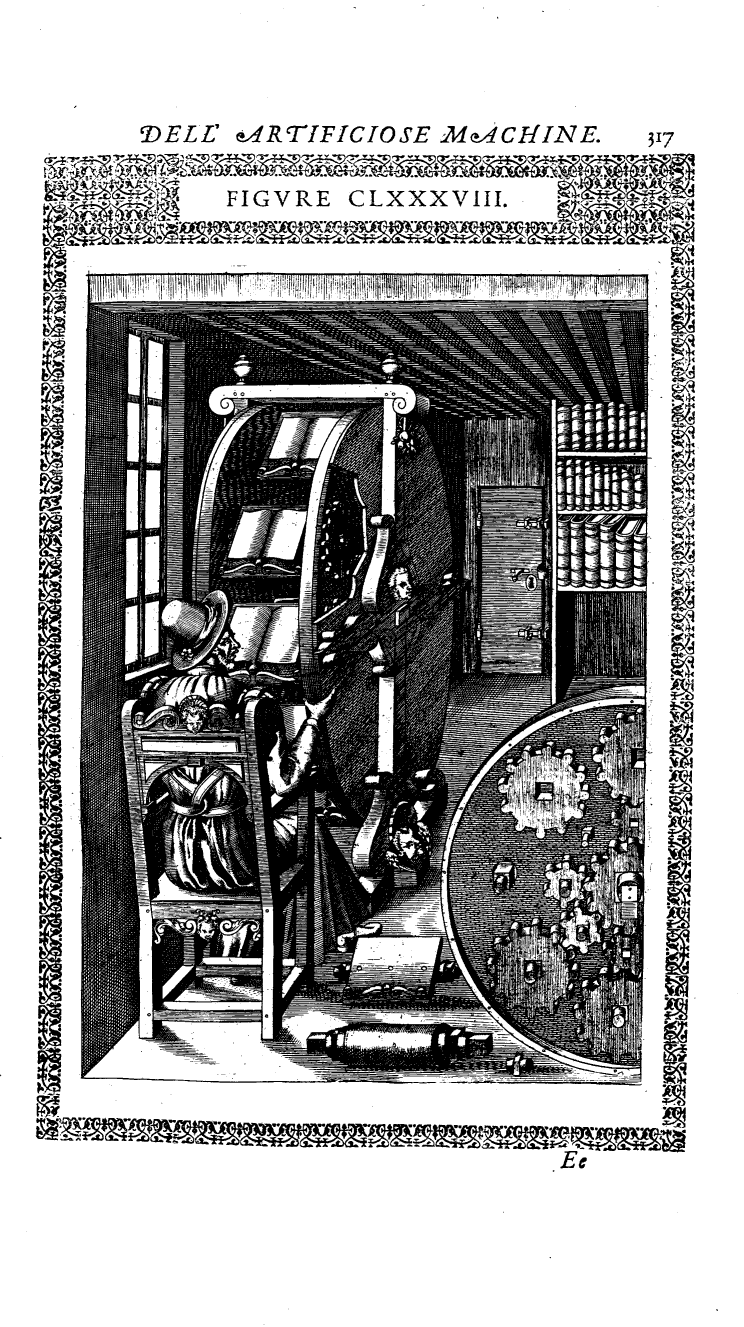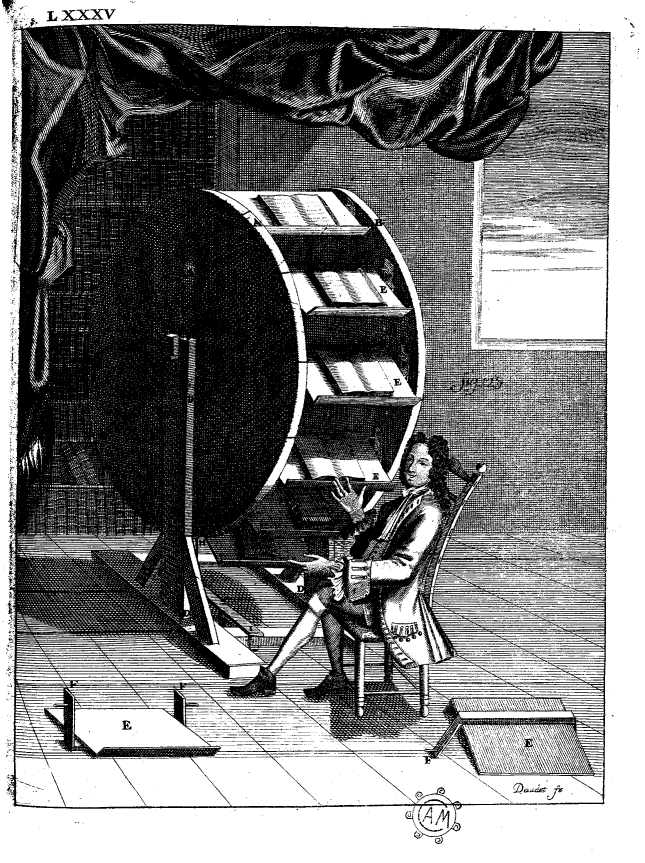The book wheel contained in Ramelli's famous book of machines has been cited many times as evidence of an explosion of primitive information technology in the sixteenth century. The representation of the wheel contains its own lessons in information and how it breaks down.
1. Ramelli. 1588. The original. It's unclear who engraved the plate, possibly a young Jean de Gourmont. Ambroise Bachot may also have had some involvement in the creation process. Another possibility is that the plate was created by an unknown artist from an atelier associate with Gourmont.
 2. Zeising. 1611. Heinrich Zeising compiled the work of several earlier authors. The volume was printed by Henning Grosse, who also reprinted a complete translation in 1620. The plates may have been etched by a young Andreas Bretschneider. Many of the plates contain the "AB" monogram, but the flourish differs from his later work. Bretschneider settled in Leipzig in 1611 and began working with Grosse almost immediately. He also engraved the plates for the Septentrio Novantiques of Hieronymous Megiserus in 1613. Perhaps a comparison would shed some more light on the possibility that he served as Zeising's engraver.
2. Zeising. 1611. Heinrich Zeising compiled the work of several earlier authors. The volume was printed by Henning Grosse, who also reprinted a complete translation in 1620. The plates may have been etched by a young Andreas Bretschneider. Many of the plates contain the "AB" monogram, but the flourish differs from his later work. Bretschneider settled in Leipzig in 1611 and began working with Grosse almost immediately. He also engraved the plates for the Septentrio Novantiques of Hieronymous Megiserus in 1613. Perhaps a comparison would shed some more light on the possibility that he served as Zeising's engraver.3. Ramelli. Schatzakammer... (1620). Henning Grosse printed an almost complete copy of Ramelli's work in 1620. The plates were clearly engraved by Bertschneider although it's unclear who actually did the translations or how they differ from Zeising's commentary of nine years ealier. It's interesting that Grosse elected not to use the earlier plates especially given the high costs of engraving. Grosse may have only served as the printer for Zeising and had little control over the original plates. It's also possible that Grosse was trying to appeal to a new up-scale market for the work. UPDATE: I just noticed the details in the glazing. The Grosse plate shows a circle pattern that is present in the Zeising version but absent in the original.

4. Schreck. 1627. Terrence Schreck was a Jesuit missionary working in China. He was also an astronomer who corresponded with Galileo about his observations. While in China, he worked with Wang Cheng to create a work to describe western technology. The Chinese copy of Ramell's wheel is far from perfect. It seems that the engraver had little understanding of epicyclic gearing and described a device that would be very effective at dumping books to the floor. It's possible that the engraver worked from Zeising's version rather than Ramelli's original. UPDATE: I've changed my mind. It seems likely that the engraver worked from the original. Note the number of door latches. The Zeising and Grosse versions show only one latch on the door but the original has three. The Schreck version also has three.

5. Grollier de Serviere. 1719. The book wheel makes its final appearance in the eighteenth century. Instead of the complicated gearing mechanism employed by Ramelli, this version employs a much simpler gimbaled design. Whereas Ramelli used his work to demonstrate his prowess with gearing assemblages, Grollier de Serviere appealed to utility.
 6. A Bookwheel at Wolfenbuttel. Perhaps Liebniz used something similar to this recreation of Ramelli's design.
6. A Bookwheel at Wolfenbuttel. Perhaps Liebniz used something similar to this recreation of Ramelli's design.
7. And at the Smithsonian.

8. And Anthony Grafton's office.
I suspect that this wheel was the one featured in "New Worlds, Ancient Texts", a 1992 exhibition at the NYPL. According to a review in the Journal of American History (80.1: 187) the wheel was designed by Dante Gnudi and was built by "Design Models" (???). According to both Bert S. Hall and Ladislao Reti, Gnudi had also built a reduced scale version of the wheel.


